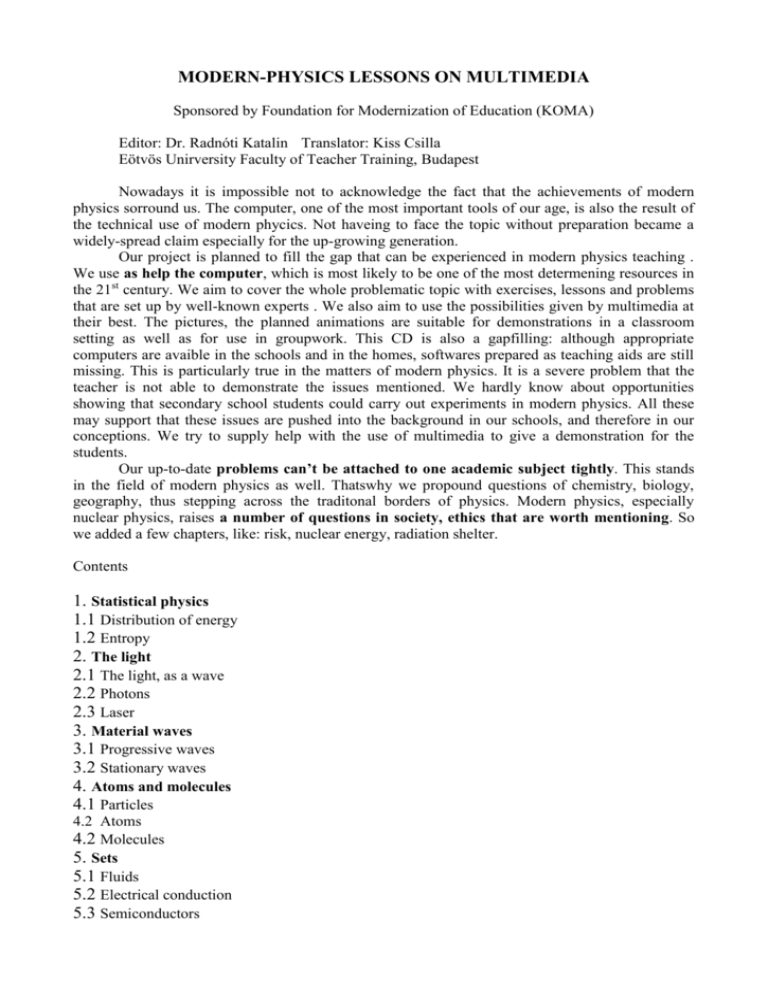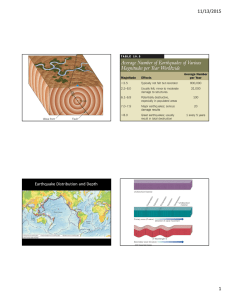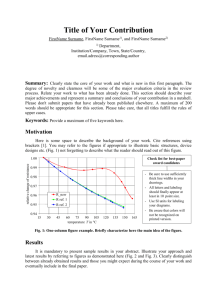MODERN-PHYSICS LESSONS ON MULTIMEDIA
advertisement

MODERN-PHYSICS LESSONS ON MULTIMEDIA Sponsored by Foundation for Modernization of Education (KOMA) Editor: Dr. Radnóti Katalin Translator: Kiss Csilla Eötvös Unirversity Faculty of Teacher Training, Budapest Nowadays it is impossible not to acknowledge the fact that the achievements of modern physics sorround us. The computer, one of the most important tools of our age, is also the result of the technical use of modern phycics. Not haveing to face the topic without preparation became a widely-spread claim especially for the up-growing generation. Our project is planned to fill the gap that can be experienced in modern physics teaching . We use as help the computer, which is most likely to be one of the most determening resources in the 21st century. We aim to cover the whole problematic topic with exercises, lessons and problems that are set up by well-known experts . We also aim to use the possibilities given by multimedia at their best. The pictures, the planned animations are suitable for demonstrations in a classroom setting as well as for use in groupwork. This CD is also a gapfilling: although appropriate computers are avaible in the schools and in the homes, softwares prepared as teaching aids are still missing. This is particularly true in the matters of modern physics. It is a severe problem that the teacher is not able to demonstrate the issues mentioned. We hardly know about opportunities showing that secondary school students could carry out experiments in modern physics. All these may support that these issues are pushed into the background in our schools, and therefore in our conceptions. We try to supply help with the use of multimedia to give a demonstration for the students. Our up-to-date problems can’t be attached to one academic subject tightly. This stands in the field of modern physics as well. Thatswhy we propound questions of chemistry, biology, geography, thus stepping across the traditonal borders of physics. Modern physics, especially nuclear physics, raises a number of questions in society, ethics that are worth mentioning. So we added a few chapters, like: risk, nuclear energy, radiation shelter. Contents 1. Statistical physics 1.1 Distribution of energy 1.2 Entropy 2. The light 2.1 The light, as a wave 2.2 Photons 2.3 Laser 3. Material waves 3.1 Progressive waves 3.2 Stationary waves 4. Atoms and molecules 4.1 Particles 4.2 Atoms 4.2 Molecules 5. Sets 5.1 Fluids 5.2 Electrical conduction 5.3 Semiconductors 2 6. The nucleus 6.1 Light nuclei 6.2 Heavy nuclei 6.3 Radioactivity 7. Analysis of materials 7.1 Infrared spectroscophy 7.2 NMR spectroscophy 7.3 Analysis with neutron activation 7.4 X- ray fluorescense 8. The use of nuclear energy 8.1 Medical practice 8.2 Industry 8.3 Production of energy (It is the topic of the DEMO.) 9. Hazards and protection 9.1 Protection against radiation 9.2 Hazard 10. Questions of cosmology 10.1 Theory of relativity 10.2 Astronomy 10.3 The basic elements of materials - Each topic begins with a theoretical summary, where pictures, videos and animations are added (Fig.1.). Fig.1. - In the text everywhere hypertext windows, lexicon and resumes are avaible (Fig.2.). 3 Fig.2. - Then an exercise comes next with a window included. In the registration the exercise and a figure shows up. To each exercise a figure, a picture, or an animation is attached. A wide variety of tools is supplied to help the progress of solution, like: encyclopaedia, formulae, charts, list of material and universal constants, calculator, statistics, counsellor, (Fig.3.) etc.. Fig.3. - The solution of the exercises with explanations can be reached also (Fig.4.). 4 Fig.4. We find the role of the this outstanding as not only the result is important in a scientific problem, but also the judgement of the connection with reality. We want to teach effectively: we want to give new information, and show the possible applications.











